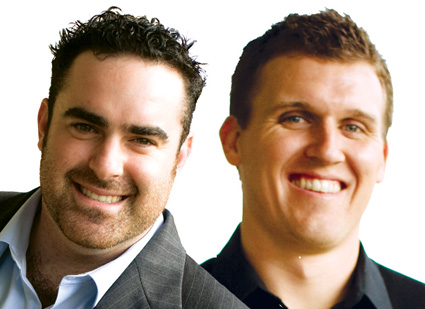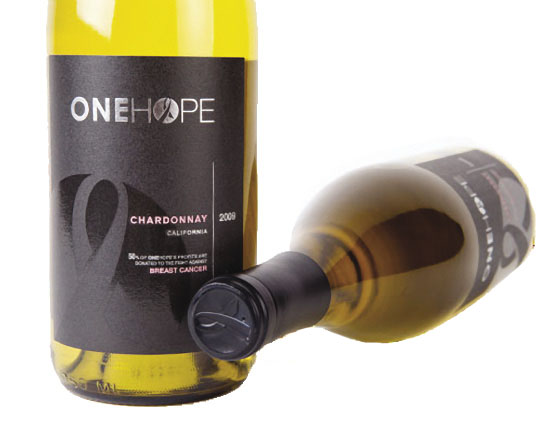


![]()
ONLINE


Jake Kloberdanz and Brandon Hall
A Brand
with a Cause
Editors’ Note
Jake Kloberdanz has been recognized by Businessweek as one of the “Top 25 under 25”, OC Metro’s “Top 40 Under 40”, and was the youngest nominee for Entrepreneur of the Year by Ernst & Young, and the youngest male nominee for San Francisco’s Man of the Year for The Leukemia & Lymphoma Society. Kloberdanz was a three-year Scholar Athlete at UC Berkeley graduating from the Haas School of Business and took home two national championships in college rugby. He has served over 5,000 volunteer hours since 2001 and has been widely referred to as an expert in cause marketing and branding by numerous organizations and people.
Brandon Hall attended the University of California, Berkeley and graduated with a degree in American Studies. After working one year for E.&J. Gallo in Southern California, Hall joined forces with seven close friends to start ONEHOPE Wine. In 2009, he was recognized in the OC Metro’s annual “Top 40 Under 40”.
Company Brief
Since its inception in 2007, ONEHOPE Wine has grown rapidly due to a respected and positive presence in all charitable fields. It has become the socially conscious wine of choice at several hundred premier events including the Grammys, the American Red Cross Gala, the BAFTAs, Sundance Film Festival, and VH1 Save The Music. To date, ONEHOPE has raised over $750,000 for a wide range of charitable organizations and donates half of its profits to partner charities benefitting a variety of causes. The unique label is offered in hundreds of reputable hotels, restaurants, bars, and retail stores in select markets across the nation, and can be purchased online at www.ONEHOPEWine.com.ONEHOPE was started by eight friends who turned what started as a personal mission to help out a friend with her fight against cancer into a thriving business, which is founded on the principle that giving back is good business.
How did the partnership among those who created this brand come about?
Hall: It was around 2005 when Jake first thought about creating a brand that raises money for causes year round while delivering a high quality product. Jake looked no further than to some of his best friends and most respected teammates at E.&J. Gallo to develop the company.
He told us about the idea, but it didn’t get going until one of his best childhood friend’s was diagnosed with Hodgkin’s Lymphoma at 22 years of age. He then went out and incorporated our business and throughout the next year, we bottled three palates of wine, quit our jobs, and started selling wine out of the back of our cars.
Kloberdanz: As the brand has transitioned from Hope Wine to ONEHOPE, our vision has grown into being a leader in weaving cause into the fabric of a company. Rather than simply building a wine brand with a temporary cause marketing campaign, we make cause part of our everyday goals and the foundation of our brand. Marketing in the form of donating is more effective, builds brand loyalty, and makes more people willing to tell others about what we are doing. In essence, we spend a dollar donated better than other companies spend a dollar on marketing, and we participate and volunteer with the causes we stand by to make our commitment authentic and genuine year around.

ONEHOPE chardonnay
Once we started growing, we knew we needed a better partnership with a winery and a winemaker with a reputation behind the name. So we officially re-launched our brand in late 2010 with Michael Mondavi’s son, Rob Mondavi Jr., as our winemaker.
With so much need, how did you decide which areas to support and how did you link the varietals to charity concepts?
Kloberdanz: We started with a chardonnay that supports breast cancer, a cabernet that supports autism, and a merlot that supports AIDS awareness. Women enjoy chardonnay 2 to 1 over any other varietal and breast cancer affects 1 in 9 women in the U.S.; AIDS is a worldwide epidemic and merlot is one of the most widely used grapes around the world; and a good friend of the company who has an autistic child was the root of focusing on autism at the time, and since 4 of 5 children with autism are male and cabernet is most popular among men, we thought it was a fitting pairing.
Hall: Within two years of our start, we launched the zinfandel for the troops because the zinfandel is known as the “All-American grape” as well as for having a very tough skin. Also, numerous founders have parents, grandparents, and close friends who have served and are currently serving our country. And the sauvignon blanc that supports the environment is commonly referred to as a “green” or “grassy” wine.
What is next for ONEHOPE?
Kloberdanz: We were the first wine brand to commit to multiple causes all year around, so we are interested in using our assets of a strong brand identity in the cause space and proprietary technology to empower social entrepreneurs and other business leaders who are trying to do good. We have started to entertain licensing deals and expanding into other verticals in the beverage industry. We are taking our “cause platform” into additional spaces including the at-home wine market with Hope at Home, a subsidiary that is taking the Tupperware party model into the wine industry; the wedding market with ONEHOPE Weddings (ONEHOPEweddings.com) where over 5,000 brides have signed up to use ONEHOPE as the wine of choice in their wedding or for wedding favors; and into the direct-to-consumer wine market with Craft1933 (Craft1933.com), taking what we are doing with a bottle of wine and providing a platform for hundreds of other wineries throughout Napa, Sonoma, the west coast, and internationally to market their wines to socially conscious wine lovers while helping raise money for their cause of choice.
How is Cause-Centric Commerce (CCC) relevant to your business and where do you intend to take it?
Kloberdanz: Cause-Centric Commerce refers to building a cause into a business model and root culture. Jerry Welsh, a partner at ONEHOPE, is recognized as the inventor of Cause Related Marketing (CRM), which has helped raise over $5 billion for charity. But our next decade’s problems will need more from the private sector than just effective marketing campaigns. We need all businesses to build a higher purpose into their models so the most effective organizations in the world can impact humanity in a major way. We are taking the lessons we have learned with integrating cause into our culture, brand, and company goals and using them to empower other companies. We are also building technology and platforms to help these companies and individuals integrate CCC into their organizations.
Over the next 10 years, Cause-Centric Commerce will replace Cause Related Marketing. This is a movement that transcends generations and isn’t just a dream of a bunch of young entrepreneurs – it will happen.•